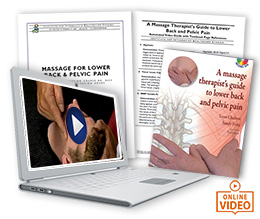6 Hour CE Course

Responsible for over 90% of all reported backaches, "non-specific" backache has no actual associated pathology. Massage therapy and soft tissue and exercise methods have been shown to be the most effective way of treating – and preventing – this widespread problem. Through course and video you will discover the evolution of 'non-specific' backache as well as assessment and treatment methods ideal for use in combination with massage therapy derived from physical therapy, osteopathic and chiropractic sources. The supplemental videos demonstrate the palpation and treatment methods for learning enhancement.
Through both online text and video, authors Sandy Fritz and Leon Chaitow will:
Good program. Wish I could have watched the videos on disk instead of going online. Some of the videos were poor quality by way of being blurry & sound was hard to hear for most. Had to turn up speakers very loudly to hear most.Julie Morgan-Stom, NCTMB
Good course. Lots of good information, and many other techniques to incorporate in my work.Laura Utrecht, RMT
This is quite thorough. I teach yoga as well as work as a massage thrapist. It is quite beneficial to both!Brooke Fiske
I found the course very informative. Valuable descriptions of problems that might mimic muscle issues. Enabled me to be able to put into use some tests I had learned years ago, but didn't really know what the results meant. Great course.Diane Curry Taylor, LMT
Great class. Brushed up on techniques I knew as well as learned some added bonuses!Judy Wade, AMTA
I really enjoyed being able to participate in this class. Back in the early "90's" I had the opportunity to take a couple of workshops with Leon Chaitow. He was a remarkable teacher with wonderful insights. This is a great class!C.M. Micheals, LMT, NCTMB
This is a great program. I will surely be taking my next courses on here!Amailly Mendoza, LMT
It was great to have the video in addition to the materials on line. Thank youLucia Chan, LMT
Great class! I learned many new techniques and will definitely be able to apply them to my practice. This class is very detailed.Amy Hogan
I found this to be the best online continuing education course I have taken. The material is extremely detailed and dense with information, in addition to there being many useful videos. However, as a result of all this useful content, I found that the course took FAR more time than the allotted six hours. I am a fast reader by any standard, but it took me a minimum of 16 hours to cover the course material in a way that I could begin to absorb it so it is useful to me. It's a great course, but I would assign it more hours so that one can obtain the credit that it's worth as well as allow a reasonable amount of time to complete it if one is on a deadline.Stephanie Letson
I love this course and plan on more extensive study on the subject. Thank you!Donna Ramirez, LMT
This course has quite a bit of information. The videos made the class more interesting. The course material was a bit of a difficult read. I would recommend this course for those wanting to learn evaluation of muscle, techniques. I found the course to take me many hours to complete. I found the test to be a high degree of difficulty, but the test did ensure an understanding of the subject matter.Donna Rasulo, LMT
There is definitely a wealth of information in this course. It's one of my favorite courses that I have taken. I have already incorporated some of the techniques into my massage practice.Donna Marland, LMT
Great course, great videos, will use in my practice!Hilary Kula, LMT
Nice course, I learned a lot and refreshed previous knowledge.Johanna Morawski, LMT
I found this course to be helpful and interesting. I would recommend it anyone looking to add skills to their practice.Kimberly Repscha, LMT
The materials were very specific and easy to read and understand. There was a few questions I had a hard time with but overall it was an educational CEU course.Shelby Garrett, LMT
I found the information on the videos especially very informative and helpful.Martha Young, LMT, BCTMB
I felt the course was informative and comprehensive. I think it should be a 10-12 hour credit course. To read all the pages of text, view all the videos enough times to retain it, and review the text and videos to commit the information in each topic to long-term memory, not just short term memory takes longer than 3 hours. I have found all your courses of study to be well worth the time and money invested in taking them.Cheryl Taylor, LMT
Overall the course contained information that is relevant and interesting. I would like the video to be more clear especially when showing thumb techniques it was barely legible. Otherwise, I found it very helpful and informative. Thank you.Jannett Schneider, RMT
This material was incredibly thorough and so well written. Videos are great too. Hopefully, I will be able to access the info periodically. Best course I've taken so far, ever. Thanks !!Bonnie Britton, LMT, BCTMB
This course had so much information, that it was amazing and a little overwhelming. I think it should be an 8 to 10 hour ceu class!!! I really will need time to assimilate all the information, but it was great quality! Thank you for such a quality class!Lynette Nicoll, LMT
Good information, required you to study hard. Overall good materialFay Andrews, CMT
Information was very detailed and the added videos were very helpful. Thanks !Karen Lodes, LMT


Take our free online course: Ethics Refresher
We will not rent/sell your email to anyone.
You'll also receive our newsletter and special offers.
Thank you! An email will be sent to the address provided with instructions on how to enroll in this 1 CE hour course - FREE!
If you do not see our email within a few minutes of signing up, please check your Spam/Junk folders it may have been delivered there instead of your inbox.
If, by chance, you still have not received it within 5 minutes, please call us at 1-800-364-5722, Monday-Friday, 9am-5pm EST for assistance.